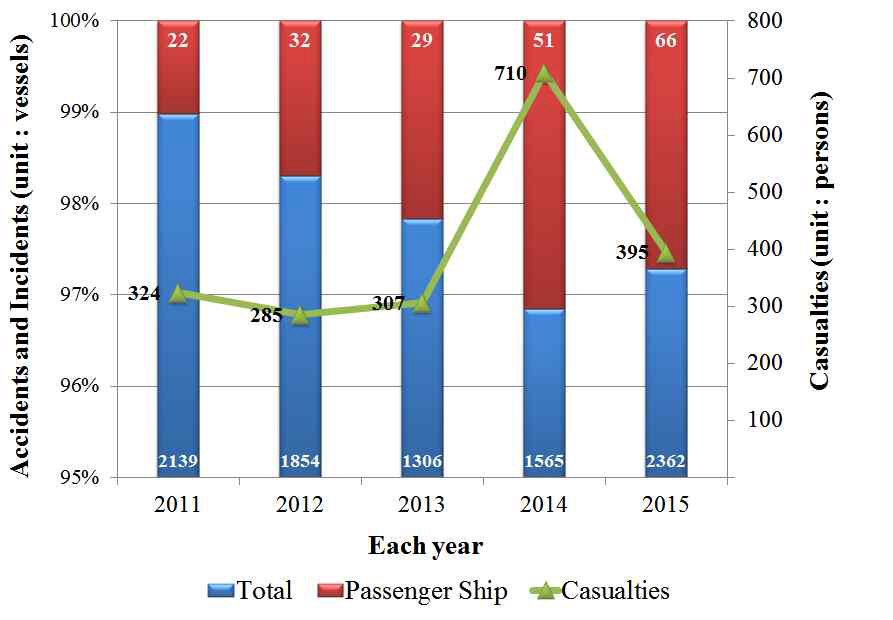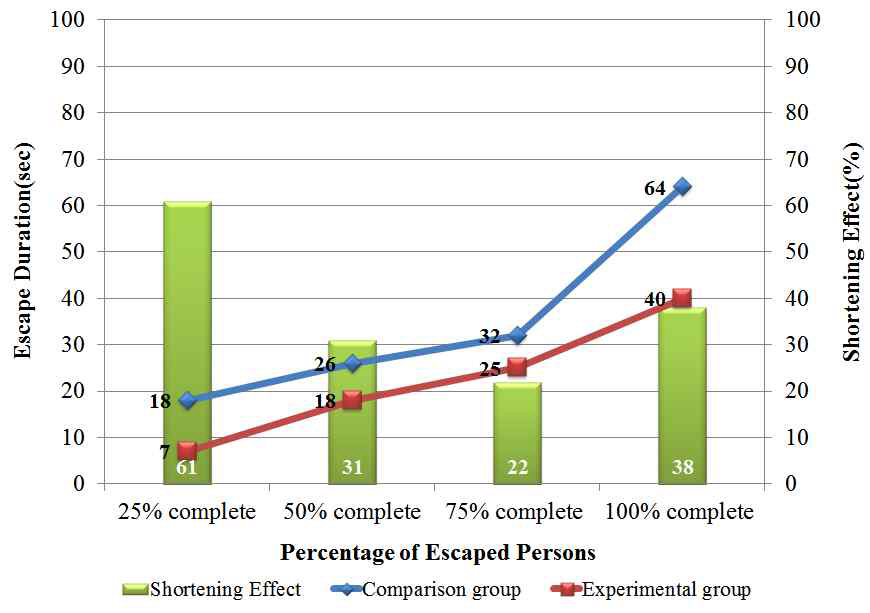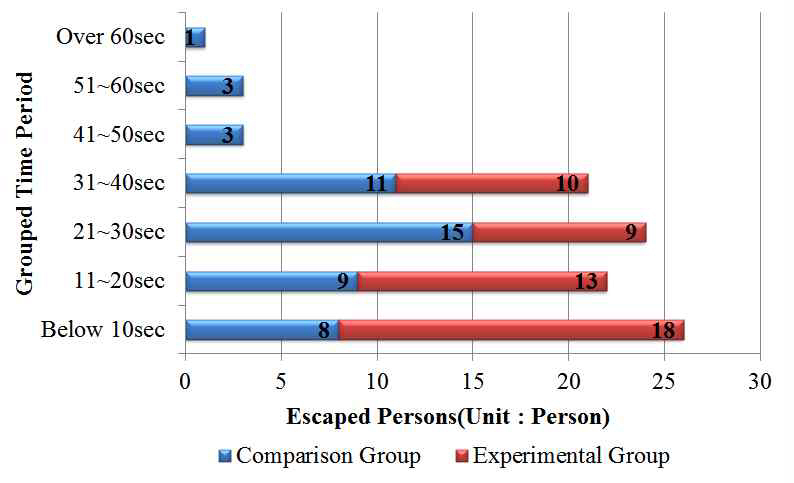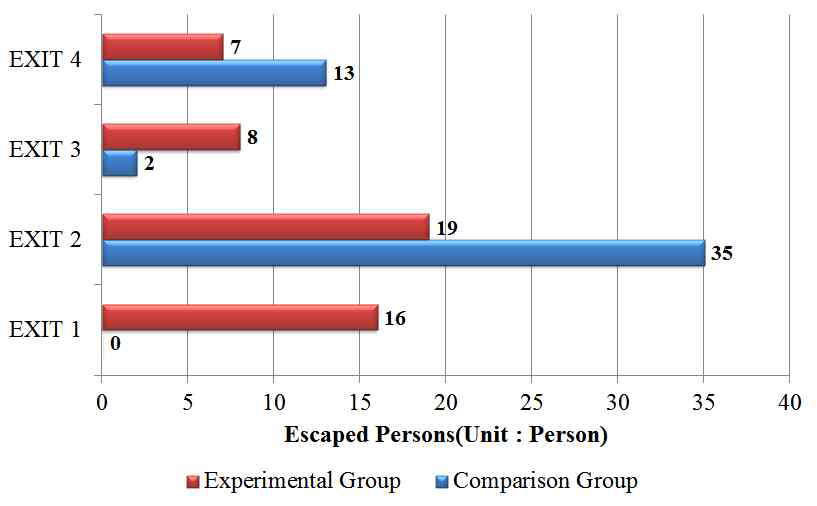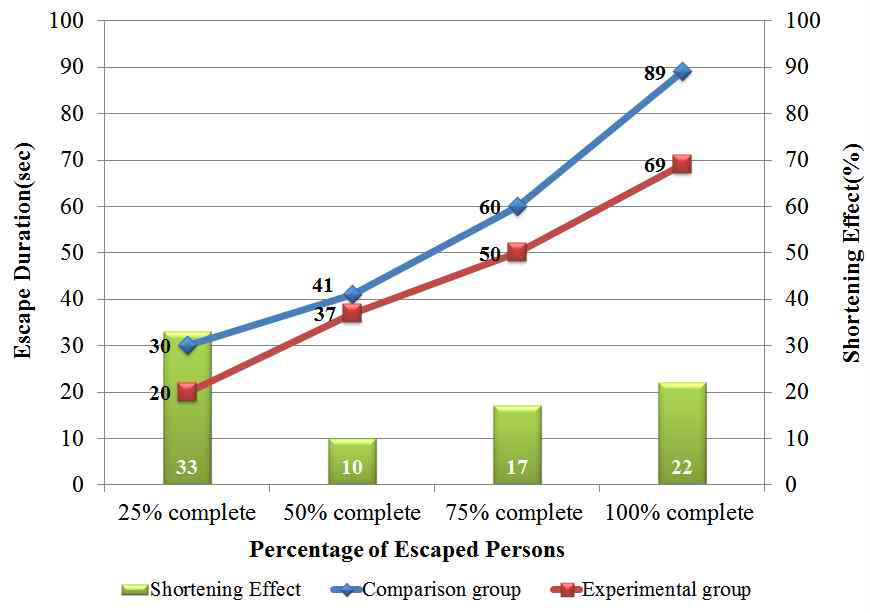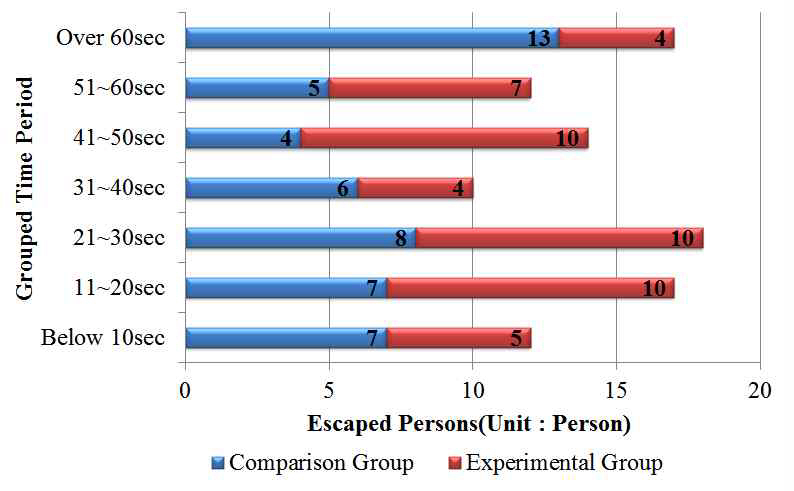Fundamental Research for Escape Guidance System Development of Passenger Ship
Article information
Abstract
This study represents a fundamental research for a passenger-ship escape guidance system that is a ship-borne agent, and it is for the support of escape decision-making by providing accurate maritime safety information in real time. We conducted a passenger escaping experiment on a training ship, SAEYUDAL, using the situation-aware escape guidance system, which has been developed for on-board application based on products for buildings. It is shown that the system contributes to the shortening of the escape duration and the dispersion of the escaping persons by generating and guiding the safe escape routes which dangerous areas are considered. From the experiment on ship's heeling condition, it is revealed that the heeling angle is linearly related to the escape duration. Therefore, this study shows that the shortening of the escape duration enables a safe and rapid mustering that is the most important process under emergency and appropriate incident responses to minimize loss of lives.
1. Introduction
The number of passengers each year has increased steadily from 11.6 million in 2006 to 15.4 million in 2015. Also the average increasing rate is 1.4% for the recent 5 years (Korean Shipping Association, 2016).
With increasing passenger transportation, the number of incidents has increased as well. Incidents in passenger ship have increased three times for the recent 5 years as shown in Fig. 1 (Korea Maritime Safety Tribunal, 2015).
Although the proportion is low as 200 cases of total 9,226 cases for the recent 5 years, the incidents are directly connected with casualties. So, it is needed to pay attention to incident response to minimize casualties.
Under the passenger ship incidents, if some factors are not understood immediately such as cause of an incident, vessel’s condition, marine weather, vessels in the vicinity, etc., it is difficult to take immediate and proper actions during golden time. The incomplete response actions make extensive loss of lives and property. Also, safe and rapid mustering is important as guiding passengers with safe and accurate escape routes under emergency situations. But it is difficult due to complicated own structure, shortage of crew members, panic for passengers and crew members, etc.
Passenger ship SEWOL is an example which sank in the coastal area around ByeongPung island, Jindo-gun, Jeollanam-do on Apr. 16th 2014. Due to delayed evacuation judgement, crew members’ shortage, etc., the incident had many casualties(172 rescued passengers and 302 dead or missing passengers). To relieve the above mentioned problem, escaping guidance system for Passenger ship has been developing by Maritime Safety Research Center, Korea Institution of Ocean Science and Technology. It is the system to support decision-making as providing accurate maritime safety information in real time in order to minimize loss of human lives in disasters (IMO SSE 4/INF.2, 2017). Also the system includes situation-aware escape guidance system which can generate and guide safe escape route considering dangerous areas as on-scene guidance agent.
This study is a basic research of the above developing system in the point of shortening escape duration. In this study, one experiment was performed to define the relations between vessel’s heeling and escape duration basically. Also the other experiment was performed to verify shortening effect of escape duration and dispersion effect of escaping persons with situation-aware escape guidance system which is a test product of developing escape guidance system.
2. Research Direction
According to SOLAS ChapterII-2 Reg 13.3.2.7 added by Res.MSC.404(96), evacuation analysis for passenger ship is used to identify and eliminate congestion which may develop during an abandonment, due to normal movement of passengers and crew along escape routes.
The application scope of the analysis becomes wider than before revision as both Ro-Ro passenger ships constructed on or after 1 Jul. 1999 and other passenger ships constructed on or after 1 Jan. 2020 carrying more than 36 passengers (SOLAS Chapter II-2 Reg. 13.3.2). It means that the importance of safety in passenger ships have been increased. Revised guidelines on passenger evacuation analysis for new and existing passenger ships was amended as well by IMO MSC.1/Circ.1533, 2016. In the revised guidelines, evacuation time is defined as shown in Fig. 2.
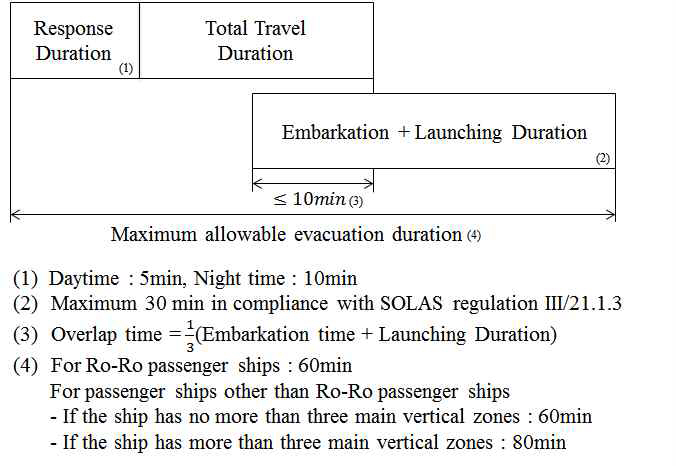
Calculation standard of total evacuation duration from initial notification of an emergency to abandon ship for evacuation analysis by MSC.1/Circ.1533(2016).
Maximum allowable evacuation duration is defined below 60min except for passenger ships other than Ro-Ro passenger ships which have more than three main vertical zones. The evacuation duration is divided to response duration, total travel duration, embarkation and launching duration. Response duration is the duration it takes for people to react to the situation which begins upon initial notification of an emergency and ends when the passenger begins to move towards assembly station. The duration generally means 5min at daytime and 10min at night. Embarkation and launching duration is the duration required to provide for abandonment by the total number of persons on board, starting from the time the abandon ship signal is given after all persons have been assembled, with life jackets donned. And the duration is defined as below 30min in compliance with SOLAS regulation III/21.1.3 (IMO, 2016).
According to Hwang, K. I.(2015), If response duration and embarkation and launching duration take maximum as regulated in SOLAS, total travel duration is allowed only 20min which is defined as the duration it takes for all persons on board to move from where they are upon notification to the assembly station.
The vessel’s condition changes every moment. That’s why time is one of important factors to reduce loss of lives. Total travel duration, which is a variable, can be easily changed according to situations than other durations. So, total evacuation duration can be reduced with shortening of total travel duration. The shortening of evacuation duration extends the time to take proper actions in response to emergency situation. In this study, two experiments were performed to consider the research direction of developing system by verifying the shortening effect of escape duration with early evacuation decision-making before excessive heeling and with situation-aware escape guidance system.
3. Escape Experiment under Heeling Condition
This escape experiment was conducted at Korea Coast Guard Academy on Aug. 30th 2016 to assess the relation between vessel’s heeling and travel duration basically with Motion-base cabin.
Motion-base cabin is a simulator which generates heeling in Vessel’s Disaster Training Ground, Korea Coast Guard Academy. With this simulator, emergency situation such as excessive heeling, capsizing and sinking can be made for training of emergency response and rescue operation. Fig. 3 is pictures of Motion-base Cabin including internal structure.
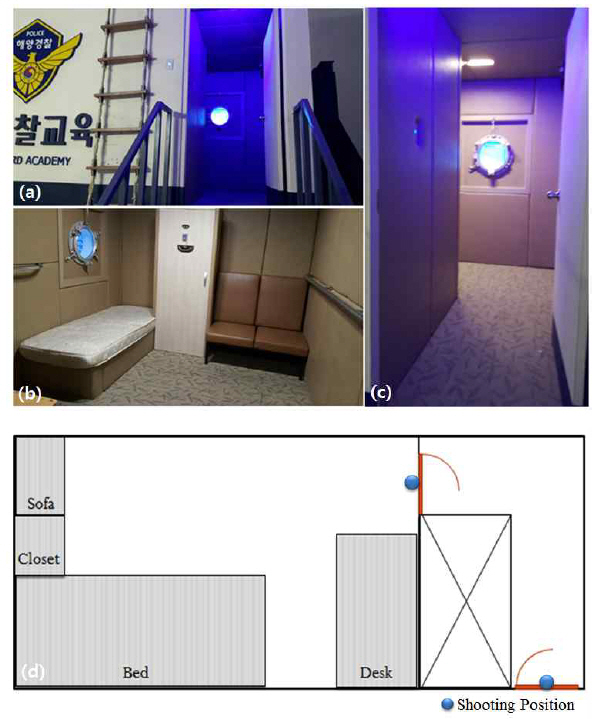
(a), (b) and (c) are photos of Motion-base cabin. (d) is internal structure drawing of Motion-base cabin.(a) shows only one entrance from outside. (c) shows a corridor connecting an entrance with cabin (b).
Motion-base cabin which is 6m in width and 3m in length is divided into corridor and cabin including sofa, closet, bed and desk. Also mats are spread on the floor and metal poles are installed on the wall due to safety reason for training.
The experiment was performed with an experimenter (Woman, 25 years old, height in 173cm, about 2 years on-board experience). Although escape duration becomes different as per sex, age, body structure and familiarity with the ship, the travel duration becomes longer due to the difficulty of moving with the inclination of the ship. This is a basic experiment conducted to investigate the direction of research and development that the heeling angle should be considered as one of the various risk factors of vessel when developing escape guidance system.
In this experiment, an experimenter moved as following Route 1 and Route 2, as shown in Fig. 4, when the heeling changes to 0°, 10°, 15°, 20° and 25° and travel duration was recorded.

Routes for escape experiment under changeable heeling condition. The Motion-base cabin tilted by bed-side making an experimenter climb up to escape. (a) is Route 1 and (b) is Route 2
As a result of the experiment, travel duration at 0°, 10°, 15°, 20°, 25° are 4s, 4.5s, 6s, 6.5s, 8s with Route 1 and 6s, 6.56s, 7.74s, 9.82s, 13.86s with Route 2, as shown in Fig. 5. According to the results, the effect of the heeling angle on the escape duration becomes clearer as the vessel size becomes larger and the travel distance becomes longer.
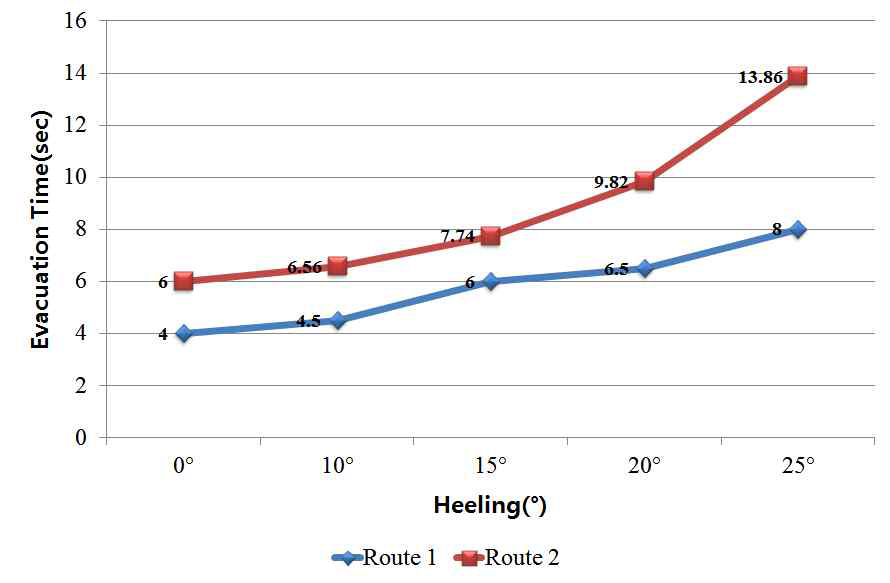
The result of escape experiment by heeling angle. Result of Route 1 is marked as blue and result of Route 2 is marked as red.
With marked result of Route 2, when the vessel’s heeling grows from 0° to 10°, the time increases 0.56s(gradient 0.056), from 10° to 15°, the time increases 1.18s(gradient 0.236), from 15° to 20°, the time increases 2.08s(gradient 0.416), from 20° to 25°, the time increases 4.04s(gradient 0.808). When it is supposed that the above grouped results are as Group 1,2,3 and 4 from top to bottom, the gradient of Group 4 is about 14 times of Group 1, 3.5 times of Group 2 and twice of Group 3 which means change rate of travel duration by heeling. In other words, the change rate of travel duration increases rapidly with large change of heeling angle. Arranged mats and metal poles in the simulator make easy to escape under the emergency situation but it can be more difficult to escape in real vessel due to huge size and structural complexity.
Kim et al.(2004) conducted a similar study with a manufactured corridor model(10m × 1.2m × 1.9m) which is similar to real ships to assess the relation between vessel’s inclination and walking speed by changing trim and heeling. When the corridor has trim, the walking speed becomes slower although change of rates by situations(by the head or by the trim) are different, as shown in Fig. 6. And when the heeling increases, the walking speed becomes slower as same as the result in the experiment with Motion-base cabin.
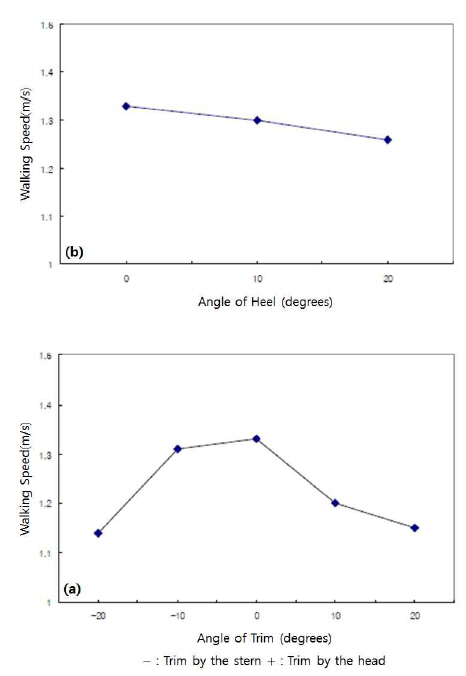
The result of experiments by Kim et al.(2004). (a) shows walking speed under trim condition(- : trim by the stern, + : trim by the head). (b) shows walking speed under heeling condition.
As seen in this experiment and similar experiment, vessel’s inclination can affect evacuation duration as well as travel duration defined by IMO(2016). The change rate of vessel’s heeling becomes more, the delayed effect of evacuation duration grows exponentially. Thus, early evacuation decision-making before excessive heeling can shorten escape duration and the shortened duration enables passengers to muster safely and to take proper action to minimize casualties. Thus the heeling angle should be considered for escape guidance system to guide safe and rapid route.
4. Escape Experiment with Situation-aware Escape Guidance System
Situation-aware escape guidance system is a developing system with spaced based SERA(Safe Escape Routing Algorithm) mathematical theory which maximize path utilization and flow, minimize congestion including bottleneck phenomenon and escape duration to exits. The system is based on smart escape guidance system for buildings and is developing to apply on board. Fig. 7.
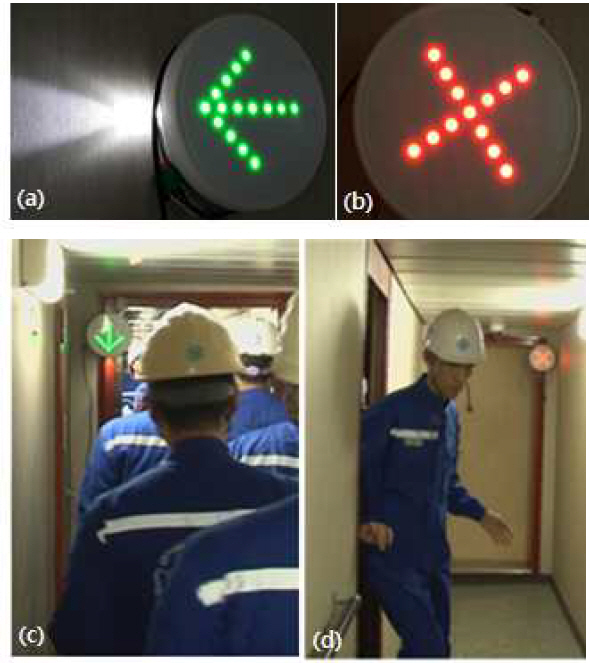
(a) and (b) are photos of situation-aware escape guiding device. (c) and (d) are photo of escape experiment at T/S SAEYUDAL with the escape guiding system.
Each escape guidance device realizes dangerous areas with built-in smoke and thermal sensors and transmits the information to central control system using LoRa radio communication. The central control system generates safe escape route with the received information (dangerous areas). The generated routes are re-transmitted to each device by LoRa and the each received devices guide the direction of safe route with voice, LED sign and illumination.
This escape experiment was conducted at T/S SAEYUDAL in Mokpo Maritime University on Oct. 4th 2016 to verify effects of the test product under the assumed emergency escape scenarios. 100 apprentices are divided into two groups as comparison group and experimental group with each 50 persons(Each 42 men, 8 women, 110 days on-board experience) whether situation-aware escape guidance system is used or not. And each person individually measures escape completion duration with a stopwatch.
Experiment environment is composed as belows.
-
3~8 persons in 12 cabins and 4 exits
(each 50 persons in comparison and experimental groups)
-
Move with normal walk without talking
(Situation with smoke and noise)
Initial notification with on-board broadcasting system
Start stopwatch when each person starts to move for measuring each person’s escape completion time
Arrangement of assistants outside unserviceable exits
The experiment was conducted with three scenarios in accordance with the number of serviceable exits under the same experiment environment. Scenarios and evaluation indices are as below.
Scenario 1 : Serviceable exits are 4 and initial fire breaks out far away from the experimental area.
Scenario 2 : Only 1 exit(EXIT 3) is serviceable and fire breaks out initially out of unserviceable exits.
Scenario 3 : The number of serviceable exits is changed 2 to 1 after 40sec from start(EXIT 3, 4 → EXIT 4). And initial fire breaks out far away from the experimental area.
Indexes of evaluation
Index 1 : Measurement of complete evacuation time individually (Analysis with time period)
Index 2 : Measurement of totally complete evacuation time for all
Index 3 : The number of evacuated persons in each exits (Measurement of dispersing guide effect)
The results of each Scenario are as below.
The result and analysis of Scenario 1
In scenario 1 which can use all exits, total escape duration was 64sec in comparison group and 40sec in experimental group as shortening 38% of escape duration.
When 25% persons completed, the difference between comparison and experiment group was 7sec with 61% shortening effect as shown in Fig. 8. It means the system has a large-effect in the early part of escape. It can be identified with Fig. 9 as comparing the number of escaped persons which are 17 persons in comparison group and 31 persons in experimental group for initial 20sec.
As well as shortening of escape duration, the system can guide the dispersive escape routes not to make stuck. The effect can be shown in Fig. 10. In case of the comparison group, the escaping persons were focused on EXIT 2 with 35 persons but the persons using EXIT 1 and EXIT 3 were a few. It is because the persons prefer to use familiar exits or educated exits before the experiment. But in case of the experimental group, the escaping persons were distributed uniformly, especially EXIT 1 which no one used in the comparison group was used with 16 persons.
In conclusion, the escape duration can be shortened with the system by guiding safe and dispersive escape route, especially in the early part, which is the most important.
The result and analysis of Scenario 2
Scenario 2 is the situation which can use only 1 exit (EXIT 3) due to fire out of the unserviceable exits. This scenario has meaning from the point of view that situation-aware escape guidance system can automatically generate safe escape route in real time considering vessel’s circumstance at the beginning of emergency situation.
For the reason when 25% persons completed, the difference between 30sec in comparison group and 20sec in experiment group becomes definite as 10sec with 33% shortening effect as shown in Fig. 11. Also the escaped persons for initial 20sec are 4 persons in comparison group and 11 persons in experimental group with three times the difference although the number is smaller than scenario 1. Total escape completion duration is 89sec in comparison group and 69sec in experimental group with 22% shortening effect. The effect looks like not so definite because limited experimental area and only 1 exit makes it easy to see the other escaping persons using safe exit. The area becomes bigger, the effect would be more definite.
The result and analysis of Scenario 3
Scenario 3 is the situation which changes the number of serviceable exits from 2(EXIT 3 and EXIT 4) to 1(EXIT 3) at 40sec from start. At the time EXIT 4 shut down at 40sec, the persons in comparison group consumed times to find serviceable exits but the persons in experimental group escaped safely and rapidly following the guided route by situation-aware escape guiding system. It can be identified with average escape duration of escaped persons after 41sec, which is 64sec in comparison group and 54sec in experimental group with 16% shortening effect. In other words, it has meaning when situation changes such as spread of fire, the system generates new safe escape routes in real time considering the situation. Fig. 12.
According to Hwang, K. I.(2014), safety consciousness of passengers was changed after SEWOL’s sinking according to survey by people using passenger ship. The survey respondents answered that they feel insecure when using passenger ships because they can be the parties to similar incidents. Also most of them tended to distrust crews because of the belief that the incident made enormous casualties with crew’s incomplete incident response.
Developing situation-aware escape guidance system is not depending on human factor mentioned above such as crew’s decision or guidance of safe route but it can generate and guide safe and rapid escape route in real time with objective information as on-scene escape assistants. shortening effect of escape duration and dispersion effect of escaping persons were verified according to the experiment.
5. Conclusion
It is important to take effective action in disaster because the incidents are directly connected casualties. Thus, there is the need for technical development to minimize loss of lives as appropriate actions when the disaster occurs in passenger ship. In this situation, it is the best part to muster rapidly at assembly station and count head of all crews and passengers. Escape guidance system is the system developing under the purpose of incident response in passenger ship to minimize loss of lives and damage of ships. In this study, we conducted 2 evacuation experiments to approach the system from the point of shortening of travel duration which is changeable according to situations.
From the first experiment, we defined that the larger vessel’s heeling, the more increasing the escape duration’s changing rate rapidly. Thus, evacuation decision-making has to be made to enable all persons to escape and evacuate safely before the vessel has unfavorable heeling. With the early decision, evacuation duration as well as travel duration will be shortened and the time for appropriate incident response will be extended.
From the second experiment, we defined shortening effect up to 38% and dispersion effect when the situation-aware escape guidance system applies on board.
The shortening of the duration is more effective at the early part of emergency situation up to 61% when crews and passengers are possible in panic. Also the time to find safe route can be shortened markedly as considering dangerous areas in real time.
With this basic research, we reviewed the direction of developing escape guidance system and the system has meaning in the point of shortening of escape duration, especially travel duration, with safety for all persons on board.
Acknowledgment
This research was a part of the project titled ‘Development of Ship-handling and Passenger Evacuation Support System', ‘Development of Safe Voyage Planning System for Vessels Operating in Northern Sea Route(No. PJT200642)’, ‘Construction of Ocean Research Stations and their application Studies, Phase 2’, funded by the Ministry of Oceans and Fisheries, Korea.
